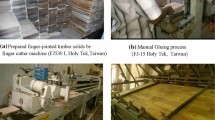Abstract
This study investigated the bending properties and joint efficiencies of some tropical hardwoods finger jointed in green and dry states. Two groups of finger-jointed pieces were produced from mill off-cuts of four different tropical timber species using PVA (protovil D3). One group was produced from pieces initially kiln dried to approximately 12 % MC while the other group was produced from green pieces (approx. 25 % MC). Solid wood test samples, treated to similar MCs as the finger jointed samples, served as a reference group. The results showed that the joint efficiencies in MOE of test group finger jointed in dry state ranged between 58 and 89 % for medium and low density species, respectively. A much lower joint efficiencies in MOE were recorded for test groups finger-jointed in green state: 49.4 and 54.7 % for medium and low density species, respectively. For MOR, the minimum and maximum joint efficiencies for test group finger jointed in dry state were 14.5 and 50.7 %, respectively compared to 12.9 and 40.1 %, respectively for test group finger jointed in green state. The results show that the joint efficiency in stiffness appears to be much higher than that in strength. Low density tropical timber species appear to exhibit higher joint efficiency than medium density ones. The synergy between density and moisture condition of wood prior to finger jointing affects the joint efficiency in MOE while only the density of species affects the joint efficiency in MOR. Finger jointing lumber with PVA may be used for non-structural applications. Further research is required to obtain enough data to confirm the possibility of using low density tropical timber species finger jointed in dry state with PVA for structural applications.



Similar content being viewed by others
References
Amoah M, Becker G (2009) Assessment of logging efficiency and development of allometric models for predicting stumpage volume of some commercial timber species in Ghana. Int For Rev 11(1):1–11
Ayarkwa J (2000) Cold and steam bending properties of some lesser-used species of Ghana. J For 9:1–8
Ayarkwa J, Hirashima Y, Sasaki Y (2000) Effect of finger geometry and end pressure on the flexural properties of finger-jointed tropical African hardwoods. For Prod J 50(11-12):53–63
Bugress R, Hansen M, Olken BA, Potapov P, Sieber S (2012) The political economy of deforestation in the tropics. Q J Econ 127(4):1707–1754
Bustos C, Beauregard R, Mohammad M, Hornandez RE (2003) Structural performance of finger-jointed Black Spruce lumber with different joint configurations. For Prod J 83(9):72–76
Duku MH, Gu S, Hagan EB (2011) A comprehensive review of biomass and biofuls potential in Ghana. Renew sustain Energy Rev 15(1):404–441
FAO 2012 State of the World’s Forests. Food and Agriculture Organization of the United Nations Rome
FPInnovations (2008) Fingerjointing Process and Product Handbook: Research and Development Summary. Forintek Division
Gorte RW, Sheikh PV (2010). Deforestation and Climate change, Congressional Research Service Report Paper 7-5700. www.fas.org/sgp/crs/mise/R41144. Accessed Dec 2013)
Houghton RA (2005) Aboveground Forest biomass and the Global carbon Balance. Glob Change Biol 11(6):945–988
Jokerst RW (1981) Finger-jointed wood products. United States Department of Agriculture. Forest Service. Research paper FPL 382. Forest Products Laboratory, Madison p 24
Mantanis GI, Karasteriou S, Barboutis I (2010) Finger jointing of Green Black Pine Wood (Pinus nigra L.). European J Wood and Wood Prod 69:155–157
Marland G, Marland S (1992) Should we store carbon in trees. Water Air Soil Pollut 64:181–195
Peskett, L, Huberman D, Bowen-Jones E, Edwards G Brown J (2008). Making REDD work for the poor, a poverty Environment partnership (PEP) Report. www.odi.org.uk/sites/odi.org.uk/files/odi-assets/publications-opinion-files/3451.pdf. Accessed Dec 2013)
Research and Development Summary (2008). Value to Wood, Finger jointing process and, product handbook RDS, 08-03 April 2008. www.valuetowood.ca Accessed Dec 2013)
Schlamadinger B, Marland G (1996) The role of forest and bioenergy strategies in the global carbon cycle. Biomass Bioenergy 10:275–300
St-Pierre B, Beauregard R, Mohammad M, Bustos C (2005) Effect of moisture content and temperature on tension strength of finger jointed black spruce lumber. For Prod J 55(2):9–16
Strickler MD (1970) End gluing of green lumber. For Prod J 20(9):47–51
Strickler MD (1980) Finger-jointed Demesion Lumber-Past, present, and Future. For Prod J 103:1664–1669
Troughton GE, Chow S (1980) Finger jointing kiln-dried and unseasoned white spruce lumber using the WFPL Method. For Prod J 30(12):48–49
UNEP (2011).Towards a Green Economy: Pathways to Sustainable Development and Poverty Eradication, www.unep.org/greeneconomy. Accessed Nov 2013
Vassilios V, Loannis B, Sotorios K (2006) Effect of PVAc bonding on finger-joint strength of steamed and unsteamed beech wood (Fagus Sylvatica). J Appl Polym Sci 103:1664–1669
Vrazel M, Sellers TJ (2004) The effects of species, adhesive type, and cure temperature on the strength and durability of a structural finger-joint. For Prod J 54(3):66–75
WWF (2009) Climate Solution Report, In: Climate Change Publications factsheets and other resources. www.wwf.panda.org/about_our_Earth/aboutcc/publications. Accessed Dec 2013)
Author information
Authors and Affiliations
Corresponding author
Rights and permissions
About this article
Cite this article
Amoah, M., Kwarteng, F.O. & Dadzie, P.K. Bending properties and joint efficiency of some tropical hardwoods finger-jointed in green and dry states. J Indian Acad Wood Sci 11, 57–64 (2014). https://doi.org/10.1007/s13196-014-0118-y
Received:
Accepted:
Published:
Issue Date:
DOI: https://doi.org/10.1007/s13196-014-0118-y




